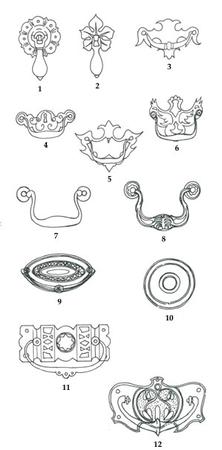Dating Antique Furniture Handles
Handles can provide a useful clue to dating antique furniture.
 Funnily enough wooden knobs were used on drawer furniture in the seventeenth century oak period until about 1660, when brass drops were introduced. Funnily, because one always associates wooden knobs with Victorians.
Funnily enough wooden knobs were used on drawer furniture in the seventeenth century oak period until about 1660, when brass drops were introduced. Funnily, because one always associates wooden knobs with Victorians.
However, brass drops rapidly came into use and oak and walnut furniture of the 1660-1710 period is usually found to have drops similar to those known in illustrations 1 and 2. The antique furniture handle on these pulls was linked to a double strip of brass or iron which passed through the drawer front and was then parted and turned over so that each end was pinned to the drawer back in opposing vertical senses. Modern reproductions have a threaded spigot with a nut to secure it.
From about 1690, however, the brass loop handle with solid back plate appeared in antique furniture hardware, as shown in illustrations 3 and 4. The back plate was shaped and could be engraved, as in illustration 5, and the loop was cast and perhaps moulded, as in illustration 3. Brass knob-shaped sockets on the face of bolts held the loop ends.
Pierced back plates were introduced about 1710 and showed many forms of which illustrations 5 and 6 are two examples. Both walnut and later mahogany furniture used the solid and pierced back plate, but by 1740 the 'swan-neck', which is often associated with cockbeaded drawers, had been introduced. This is shown in illustration 7. In this type the loop is thicker and there are merely two metal moulded circular roses behind each bolt head, without any back plate. It was an antique furniture handle type capable of considerable ornamentation, as shown in illustration 8 and the later fine quality pieces (after 1750) had very Rococo forms of this in cast and chased metal of a type found on commodes.
About 1780 the stamped brass back plate of oval or circular form associated with Hepplewhite or Sheraton furniture came into use. Illustration 9 is a typical example. This antique furniture hardware would be made from thin sheet brass, stamped to shape and hence hollow at the back.
About 1800 the turned wooden knob - illustration 10 -came into use and, although there was a period of overlap, by the time the Victorian period had set in, most drawer furniture used wooden knobs of varied simplicity or complication. Some had a simple wooden spigot to fit into the drawer front; some had a wooden threaded screwed spigot; some had a metal bolt set into them. Unfortunately the Victorians considered that the wooden knob was so desirable that they could not resist fitting il to furniture from other periods with the result that walnut and early mahogany chests in thousands have been despoiled by Victorian 'improvers'.
With the return of eighteenth century fashions, from about 1880 onwards, it was necessary to return to brass furniture handles again, although wooden knobs continued to be fitted to ordinary furniture. Illustration 11 shows a late Victorian version of a brass loop and back plate fitted to a 'reproduction' of an eighteenth century piece.
Illustration 12 shows an Edwardian Art Nouveau handle and stamped back plate as fitted to the 'simple' furniture of the period which strived to return to medieval simplicity of line!

